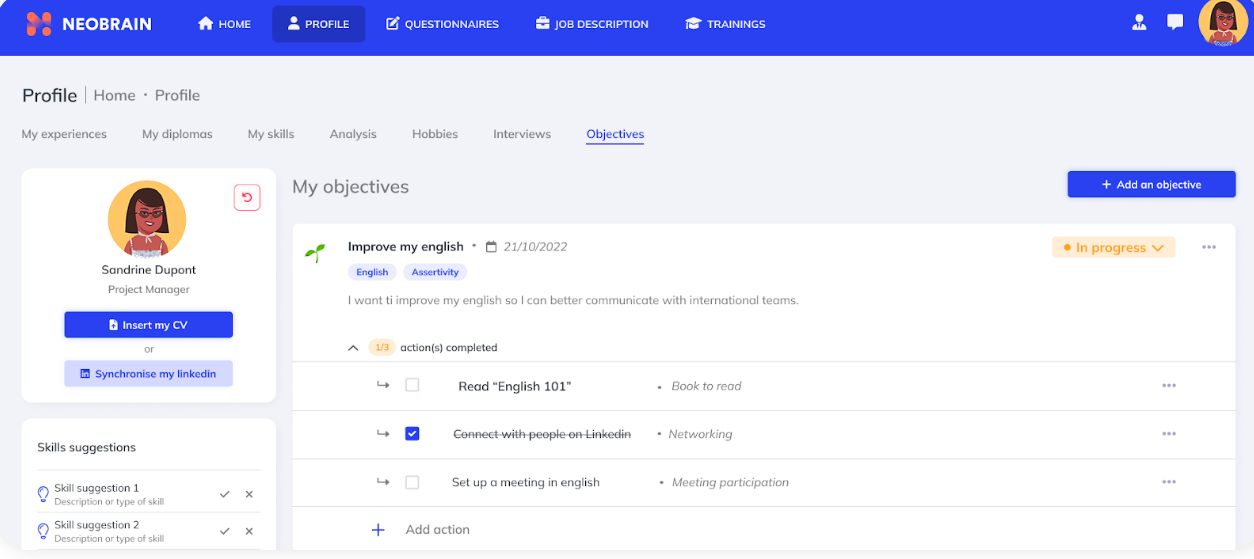Corporate performance is often measured in quantitative terms, focusing on numerical results and overlooking employees’ qualitative contributions. However, after two years of significant managerial shifts, the criteria for assessing performance are changing.
What additional criteria are used for individual performance assessment?
- Aligning behavior with the company’s sustainable performance and social contribution challenges
- Contributing to corporate culture. The importance of the values of solidarity, agility, autonomy and resilience has been amplified by the covid pandemic.
For HR departments and managers, the challenge is to enrich the employee appraisal system by integrating these two new dimensions.
How to evaluate individual performance?
In order to effectively evaluate individual performance, it is necessary to set motivating objectives and to balance them between their quantitative and behavioral aspects. In order to help individuals progress, the question of "how the performance was obtained" is too often avoided.
From now on, all individuals also provide feedback on the behavioral aspects of implementing the values stated above. The practice of 360 feedback has grown in order to enrich and objectify the evaluations of each actor in the same collective project.
Our interviewees also emphasize the importance of evaluating the manager himself. Indeed, it is often found that inadequate behavior stems from the manager’s attitude. The confidentiality of participants is essential to the success of this measurement tool and to their commitment.
How to set motivating performance objectives?
According to a Gallup study from the end of 2019, only 7% of employees say they really understand what is expected of them. Therefore, the concept of S.M.A.R.T. objectives should focus more on the employee’s understanding than on their ability to achieve them.
A goal should therefore respect the following guidelines:- Specific- Measurable- Achievable- Realistic- Within a timeframe
What are the key success factors for setting performance objectives?
- Limit the number of objectives to 5 and associate 3 Key Results on average.
- Giving access to benchmarks, getting an NPS of 40 is probably good, but where do we start from?
- Define the objectives that contribute most to the expected results.
- Set a motivating result to achieve. When employees regularly reach 100% this can result in a decrease in motivation. At Google the threshold is set at 70%.
- Give your employees and managers the habit of reviewing the achievement on a very regular basis. Only this ritual, supported by an interactive tool, will make the desired agility a reality.
How can we value performance on a daily basis?
When Denis Descause, Head of Product at Neobrain, began his adventure in Human Resources, he was particularly interested in development, performance, mobility, well-being and commitment. In doing so, he sought to understand how management could have both positive and negative effects on talent management: motivational and frustrating levers, impact of managerial styles, alignment/disalignment with employee expectations, etc.
Until one day, it became clear to him: effective talent management is built around three axes: performance, commitment and skills . This articulation became a conviction theorized in the form of an equation: the performance equation or the “relativity of commitment”. Here it is:
Performance = skills x Commitment²
Given today’s HR challenges, this theory is even more applicable to the world of work than it was then.
The notion of skill is quite factual, several categories of skills coexist, they are measurable and the HR challenge is to grasp which are the most important to amplify them in the organization. We recommend the Complete Guide to Talent Management skills.
Let’s take a closer look at the key variable in the equation: commitment.
What do we mean by commitment?
An employee's commitment can be defined as their motivation to do their best at work and to excel. For Neobrain, employee motivation has two components: extrinsic motivation and intrinsic motivation, which explains why it is squared in the equation:
- Controlled or extrinsic motivation, the most obvious. It is characterized by the link between the achievement of objectives and the bonus paid, with very limited room for optimization (by which I mean that you are unlikely to motivate a disengaged employee simply by giving him a bonus).
- Personal motivation, structured by an employee’s relationship with his or her manager and company.
This last form of motivation is the one on which action can generate the greatest improvement. To understand the catalysts and inhibitors, ask yourself which motivates you more: working for a manager who trusts you, in a company whose values you share, or working for a manager who doesn’t delegate, in a company with no recognition mechanism. Personally, I don’t need to think for very long!
Personal motivation is therefore based on notions such as respect, trust and delegation in terms of the relationship with one’s manager, and on aspects such as well-being, recognition and the work environment in terms of the link with the company.
The HR-Manager partnership: key to boosting individual performance
HR teams and managers are not always aligned on the allocation of responsibilities, yet this clarity is critical:
- HR will define the performance management strategy and the set of objective and more subjective measurement criteria for the contribution to culture.
- The manager will measure on the ground, analyze, take and give feedback to bring up the development needs.
This collaborative work begins with the centralization of HR data in order to share the data with the different levels of management. Everyone will then have a complete view of the human capital: reviews of annual interviews, evolution of the level of skills, history of positions held, training courses followed, etc., completed by the analysis of behavioral qualities.

On a day-to-day basis, the measurement of individual performance takes the form of a complete and transparent report on the yearly appraisal.
Secondly, it is essential to anchor this evaluation in the daily life of the employee and his/her manager, who will be keen to examine the contribution to collective performance.
Finally, measuring performance must be done in parallel with the evaluation of the skills of the job chosen by the employee. The final performance is the result of the adequacy of the right skill in a favorable context, and of the motivation to develop this skill.
This is why Neobrain integrates motivation in the form of continuous performance management through its“Performance and Commitment” solution.







